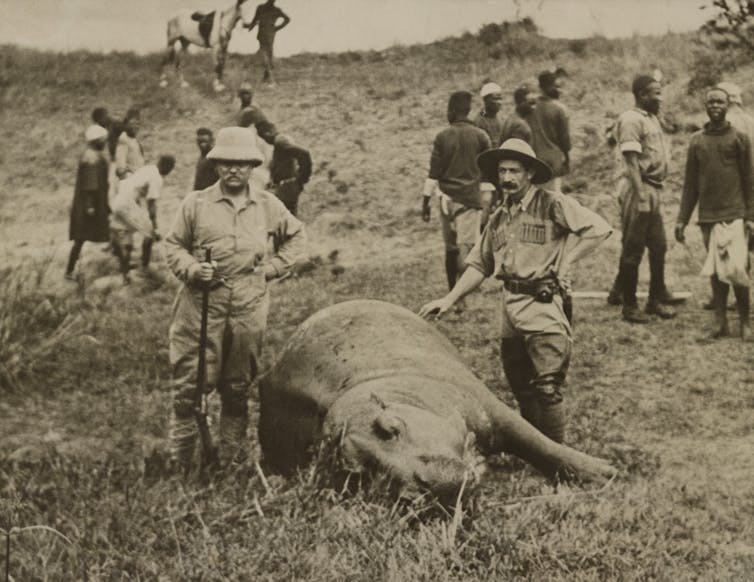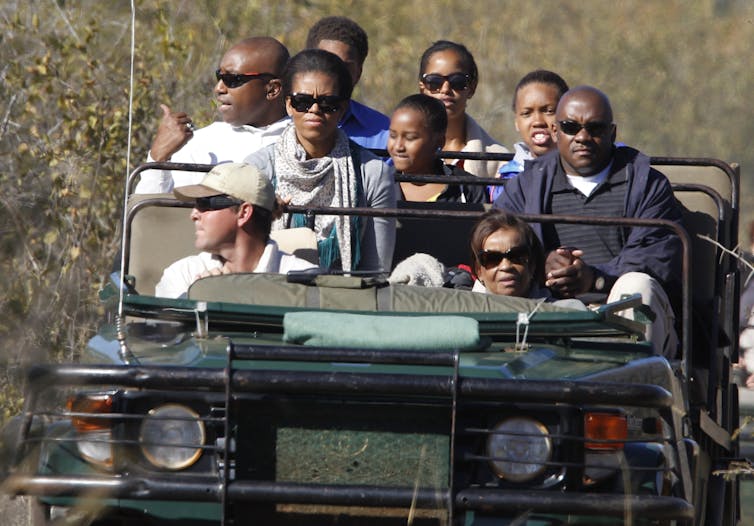Melania Trump's pith helmet is not just a hat. It's a relic of colonialism, says 91│į╣Ž expert

Published: October 15, 2018
Sometimes a hat is just a hat. But not when itŌĆÖs a pith helmet worn by a white politician visiting Africa. Pith helmets are relics of colonialism and its big game hunting tradition. So why would Melania Trump wear one?
On a solo tour of Africa, the United States first lady stopped in Ghana, Kenya, Malawi and Egypt. She went on safari. and looking rather inscrutable went around the world. Although the first lady said: ŌĆ£ŌĆØ it is impossible to not talk about the ways race and space collide in this image.
This, of course, is not the first time Trump has been challenged on her clothing choices. After she wore a jacket that said while en route to an immigrant child detention centre, many claimed .
in Africa. It is most often talked about in terms of tourism, conservation, poaching and big game hunting. .
The legacy of safari hunting
Most safari tourists, like Melania Trump, . The people driving them around, carrying their bags and doing their cooking are mostly Black. since the colonial days of explorers and big-game hunters in Africa.
In the old days, white people had the guns and wore the pith helmets. TrumpŌĆÖs choice of headgear continues that tradition.
Trump has another link to colonial big game hunting.
At the time, the Trump men argued that it was a legal trophy hunt and that trophy hunting like theirs provides funds to help communities with conservation. For example, this summer a white woman from Kentucky, , killed a giraffe in South Africa. Was the dead animal sprawled at her feet a testament to her prowess as a hunter whoŌĆÖs comfortable in the bush and knows her way around a gun? Talley said her hunt was legal and that the money she spends ŌĆ£ŌĆØ
The trouble is the line between legal and illegal becomes blurred when dollars, pounds and euros are at stake. LetŌĆÖs not forget , where the legal lines are more clear. In 2015, Cecil was lured and killed outside of a protected conservation park by Minnesota dentist and avid trophy hunter .
These are some infamous examples of American trophy hunters. Their main competitors in the African safari kills are the British and Germans.
Big-game hunters like to on social media. These kill shots are popular. ItŌĆÖs a way of bragging that the hunter was rich enough to go to Africa to hunt. In this context, it becomes just another version of conspicuous consumption.

Poaching for ŌĆśmedicineŌĆÖ
Trophy hunting is just one factor driving the extinction of rhinos and elephants in Africa. . Race and the history of colonialism are factors here too.
The road to extinction is driven by countries like China, South Korea and Vietnam. African animal parts are used in to cure a whole range of supposed ailments. The cures do not stand up to modern medicine. The rotting carcasses littering the African landscape seems to be a small price for a .
African governments are complicit in not enforcing anti-poaching laws. While this is true, it also ignores the legacy of .
African poachers killing the equivalent of their golden goose are at the bottom of the food chain; they receive a few dollars for a horn that will resell for thousands in Asia. The continent continues to be a key source of raw materials for the rest of the world. The trade in rhino horns and elephant tusks fits the .
The ivory and horn trade is ancient and has been going on for millennia. The trade was sustainable when they were a rare luxury item. The along with rising incomes; the Asian middle class can now afford it. Africa does not have a limitless supply of animals to slaughter.
My African safari
Long ago, I too went on safari, in Tanzania and Zambia. I saw the much fabled big five ŌĆō lion, elephant, rhino, leopard and buffalo. I shot them with my camera. As a Black woman, I was the rarity among the . The Africans called me the Black mzungu. In other words the Black white woman.

Camping in Ngorongoro Crater, I had to remind myself that the setting was real and that the animals could kill. This was necessary because false romantic images from movies like Born Free and Out of Africa were stuck in my head.
A Kenyan safari guide, in fact, told that MelaniaŌĆÖs pith helmet made them smile, adding ŌĆ£we havenŌĆÖt seen that look in East Africa since Meryl Streep was filming Out of Africa 30 years ago!ŌĆØ
The films and television shows are colonial fantasies. In both, the Africans were mere background characters, there to support the latter-day colonial explorers dressed up as conservationists.
Melania TrumpŌĆÖs pith helmet was never just a hat to keep off the sun. It is a symbol of how race and colonialism ghosts shape the African landscape when it comes to safari, poaching and trophy hunting.![]()
is a PhD student at the 91│į╣Ž's Ontario Institute for Studies in Education.
This article is republished from under a Creative Commons license. Read the .

